Tom's Hardware Verdict
The Gigabyte UD750GM doesn't stand out from the crowd, but it is affordable, has decent performance, and above all, it has properly set protection features.
Pros
- +
Full power at 47 degrees Celsius
- +
Properly set protection features
- +
Efficient
- +
Good soldering quality
- +
Tight load regulation at 12V
- +
Long hold-up time
- +
Low inrush current with 115V
- +
Not noisy at normal operating conditions
- +
Fully modular
- +
Two EPS and four PCIe 6+2 pin connectors
- +
Compatible with the alternative sleep mode
- +
Compact dimensions
- +
5-year warranty
Cons
- -
Not competitive overall performance
- -
Increased noise under stressful conditions
- -
Transient response could be better
- -
Loose load regulation on the minor rails
- -
Doesn't come with a (12VHPWR) 12+4 PCIe connector
- -
The specs mention an HDB fan, but we found a rifle bearing one instead
- -
Above 0.1W vampire power with 230V
- -
High inrush current with 230V
- -
PF with 230V should be higher
- -
Small distance between 4-pin Molex connectors
Why you can trust Tom's Hardware
The Gigabyte UD750GM is a decent PSU, but you won't see it among the best PSUs because for $10 to $20 dollars more, someone can get the top-performing Corsair RM750x (2021) and the EVGA SuperNOVA 750 G6.
We have already reviewed the 1000W member of the UD family, featuring a PCIe 12+4 pin connector, and we thought to also take a look at the smallest member of the lineup with 750W max power. The UD750GM is the successor of the P750GM, the first versions of which had severe reliability issues. Gigabyte released later upgraded versions of the P750GM and P850GM units. Still, there was no way to distinguish them from the older ones, and given the low popularity of these models, the best way was to introduce a new line, the UD one, which uses the upgraded P-GM platform.
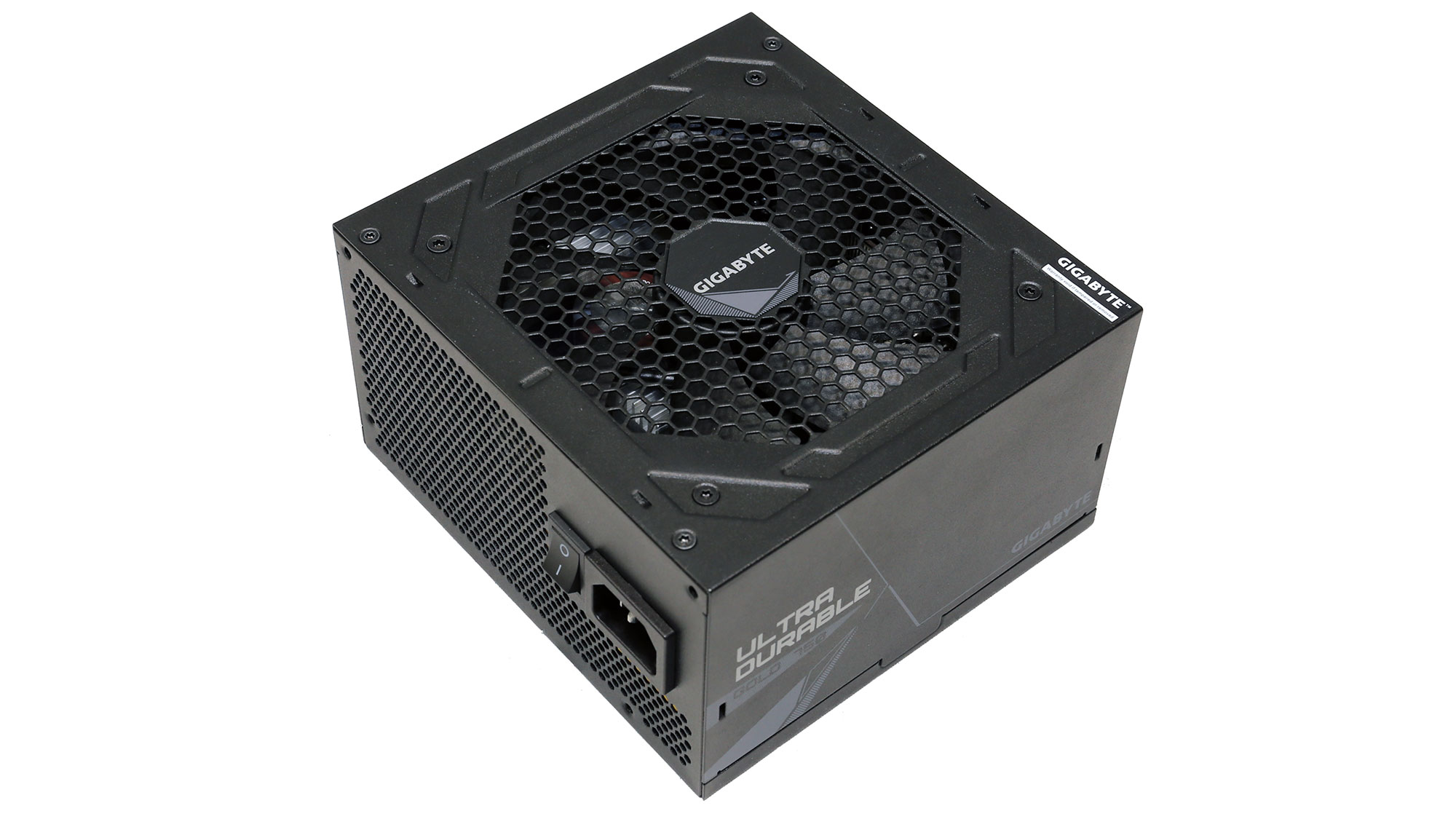


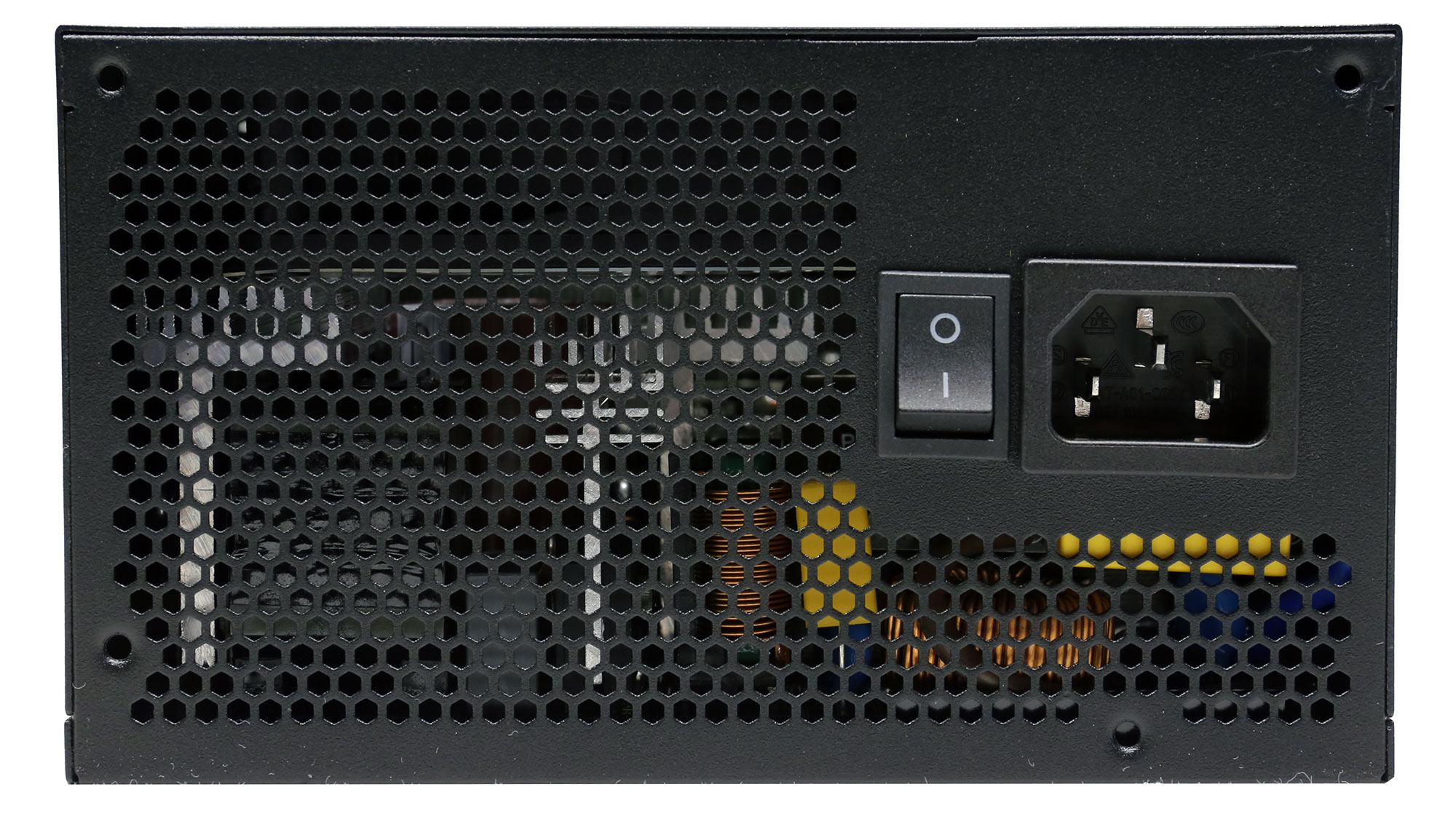


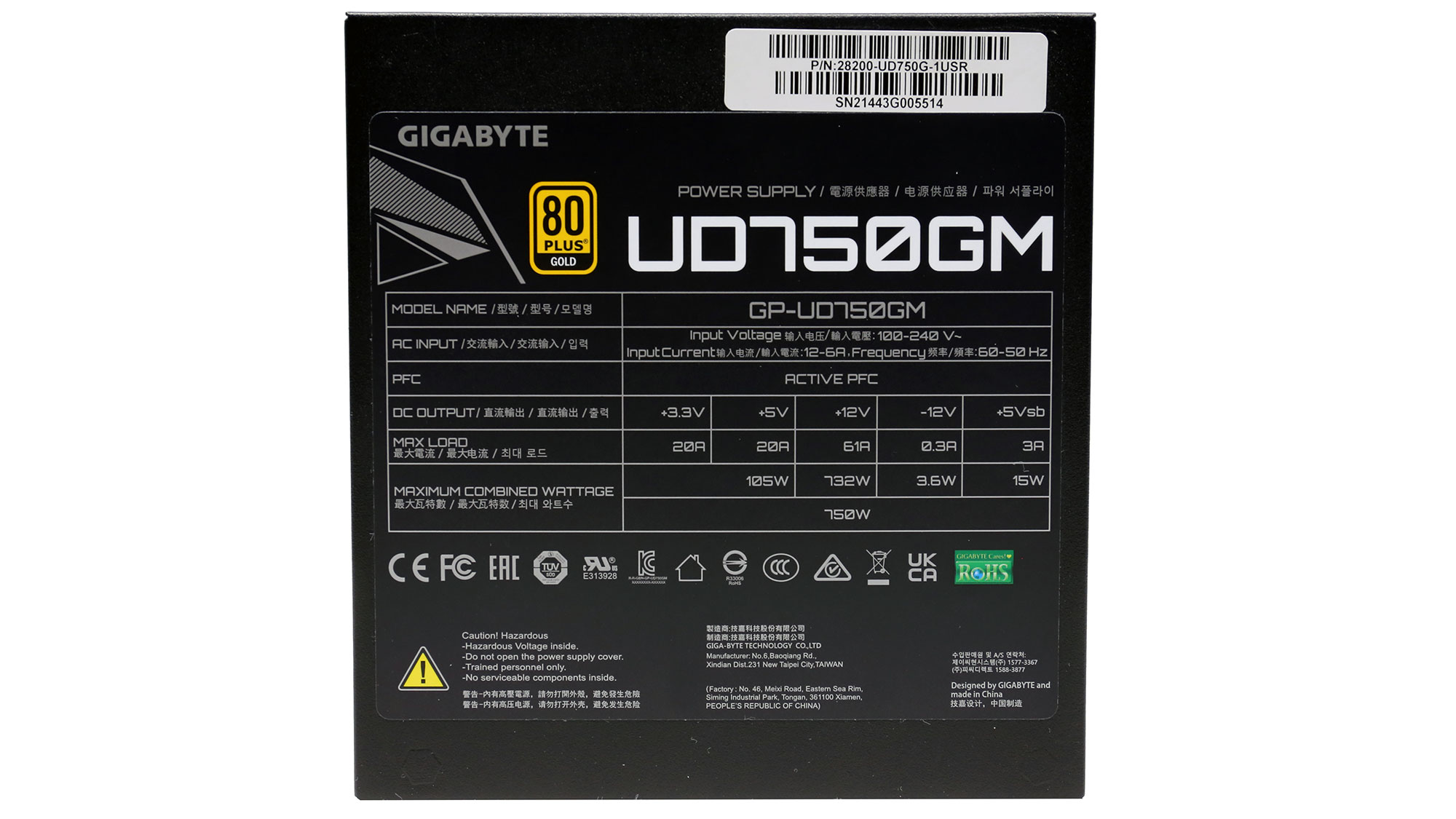




The Gigabyte UD750GM uses a fully modular cable design, and it is Gold certified by 80 PLUS. In the Cybenetics scale, it achieves Platinum and Standard++ in efficiency and noise, respectively. The MEIC platform it uses is efficient and looks to have solved all reliability issues. A little bit too late, though. The 120 mm fan uses a rifle-bearing fan instead of the advertised hydro dynamic, and the warranty is long enough at five years.

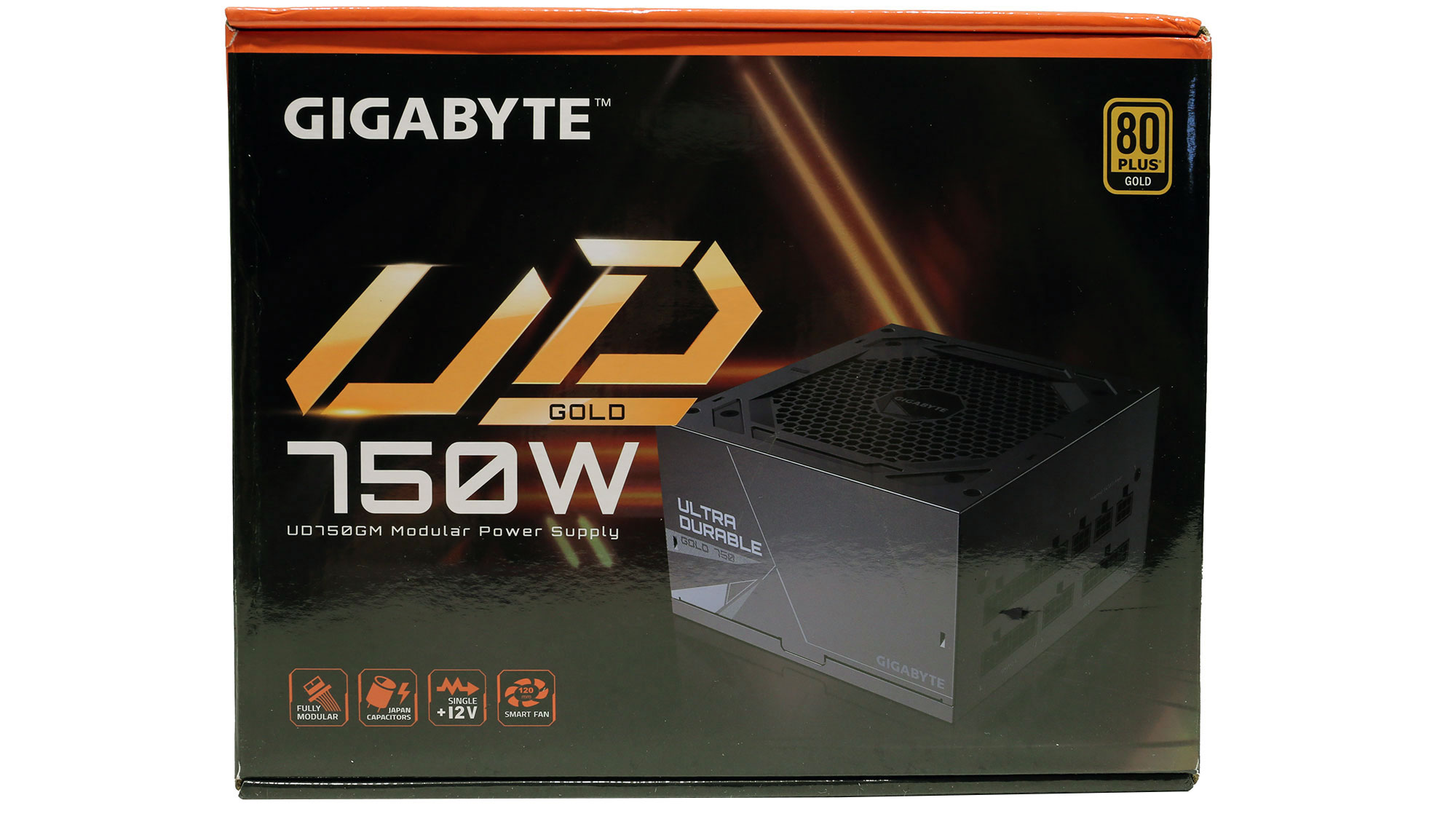



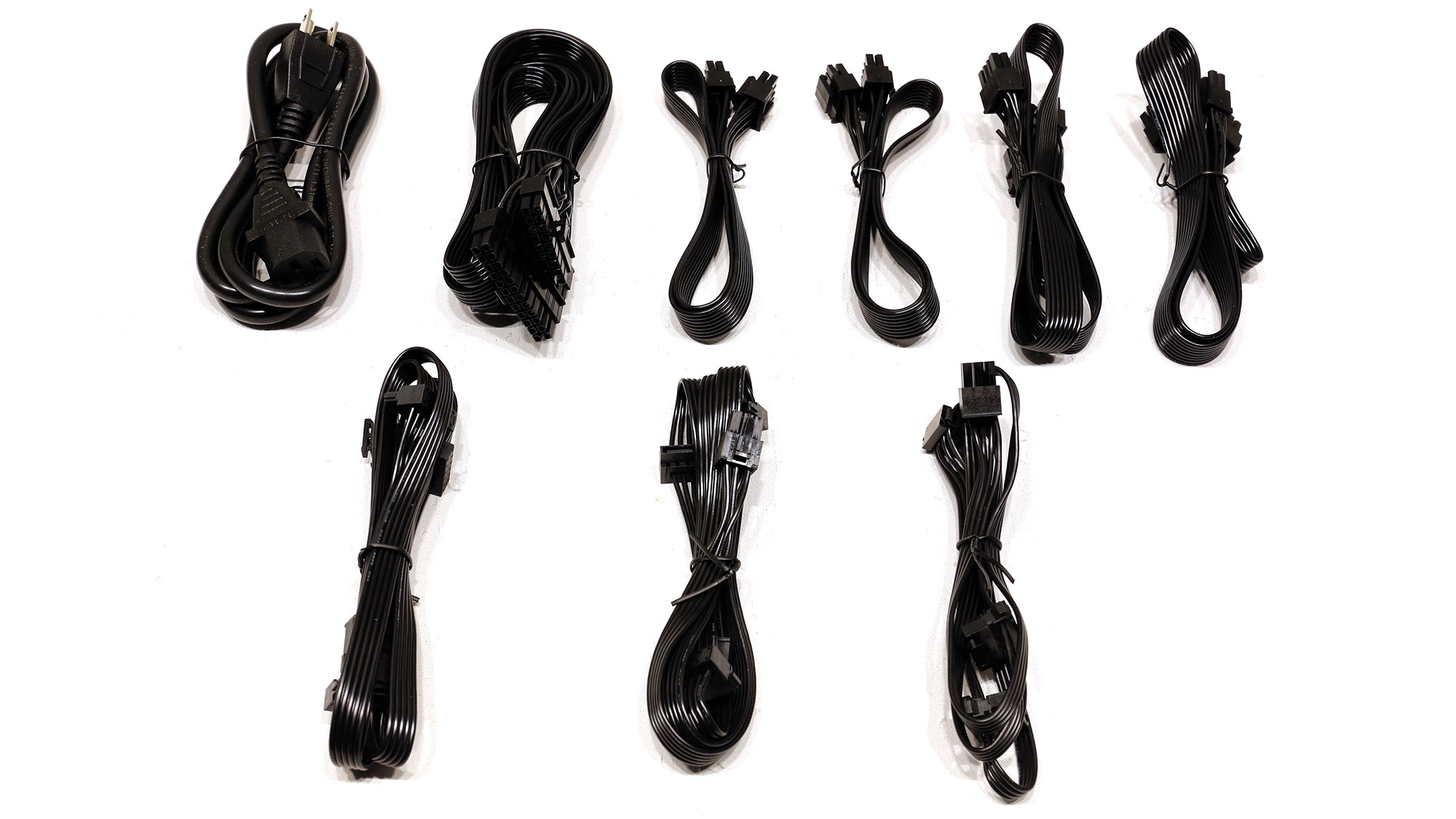

Specifications
| Manufacturer (OEM) | MEIC |
| Max. DC Output | 750W |
| Efficiency | 80 PLUS Gold, Cybenetics Platinum (89-91%) |
| Noise | Cybenetics Standard++ (30-35 dB[A]) |
| Modular | ✓ (fully) |
| Intel C6/C7 Power State Support | ✓ |
| Operating Temperature (Continuous Full Load) | 0 - 40°C |
| Over Voltage Protection | ✓ |
| Under Voltage Protection | ✓ |
| Over Power Protection | ✓ |
| Over Current (+12V) Protection | ✓ |
| Over Temperature Protection | ✓ |
| Short Circuit Protection | ✓ |
| Surge Protection | ✓ |
| Inrush Current Protection | ✓ |
| Fan Failure Protection | ✗ |
| No Load Operation | ✓ |
| Cooling | 120 mm Rifle Bearing Fan (D12SH-12) |
| Semi-Passive Operation | ✓ |
| Dimensions (W x H x D) | 150 x 85 x 140 mm |
| Weight | 1.42 kg (3.13 lb) |
| Form Factor | ATX12V v2.31, EPS 2.92 |
| Warranty | 5 Years |
Power Specifications
| Rail | Row 0 - Cell 1 | 3.3V | 5V | 12V | 5VSB | -12V |
| Max. Power | Amps | 20 | 20 | 61 | 3 | 0.3 |
| Row 2 - Cell 0 | Watts | Row 2 - Cell 2 | 105 | 732 | 15 | 3.6 |
| Total Max. Power (W) | Row 3 - Cell 1 | Row 3 - Cell 2 | 750 | Row 3 - Cell 4 | Row 3 - Cell 5 | Row 3 - Cell 6 |
Cables & Connectors
| Description | Cable Count | Connector Count (Total) | Gauge | In Cable Capacitors |
|---|---|---|---|---|
| ATX connector 20+4 pin (610mm) | 1 | 1 | 18AWG | No |
| 4+4 pin EPS12V (600mm) | 2 | 2 | 18AWG | No |
| 6+2 pin PCIe (600mm+150mm) | 2 | 4 | 18AWG | No |
| SATA (600mm+150mm+150mm+150mm) | 2 | 8 | 18AWG | No |
| 4-pin Molex (500mm+115mm+115mm) / FDD (+150mm) | 1 | 3 / 1 | 18AWG | No |
| AC Power Cord (1400mm) - C13 coupler | 1 | 1 | 16AWG | - |
The PSU includes all of connectors to deliver its full power without any problems, though it is weird that the ATX cable is longer than the EPS ones. Usually, it is the other way around. Moreover, there is no need for a floppy (FDD) connector. They could install a 4-pin Molex instead and provide a Molex to FDD adapter for users still needing this old connector. Lastly, it would be nice to have a 150 mm distance between the 4-pin Molex connectors, which is the case for the SATA ones.





Component Analysis
We strongly encourage you to have a look at our PSUs 101 article, which provides valuable information about PSUs and their operation, allowing you to better understand the components we're about to discuss.
| General Data | - |
| Manufacturer (OEM) | MEIC |
| PCB Type | Double Sided |
| Primary Side | - |
| Transient Filter | 4x Y caps, 2x X caps, 2x CM chokes, 1x MOV, 1x Chipown PN8200 (Discharge IC) |
| Inrush Protection | NTC Thermistor & Relay |
| Bridge Rectifier(s) | 2x GBU1506 (800V, 15A @ 100°C) |
| APFC MOSFETs | 2x NCE Power NCE65TF099F (650V, 24A @ 100°C, Rds(on): 0.109Ohm) |
| APFC Boost Diode | 1x JF SC0665 (650V, 6A @ 175°C) |
| Bulk Cap(s) | 1x Nippon Chemi-Con (400V, 680uF, 2,000h @ 105°C, KMW) |
| Main Switchers | 2x NCE Power NCE65TF099F (650V, 24A @ 100°C, Rds(on): 0.109Ohm) |
| APFC Controller | Champion CM6500UNX |
| Resonant Controller | Champion CM6901X |
| Topology |
Primary side: APFC, Half-Bridge & LLC converter Secondary side: Synchronous Rectification & DC-DC converters |
| Secondary Side | - |
| +12V MOSFETs | no info |
| 5V & 3.3V | DC-DC Converters: 4x Alpha & Omega AON6354 (30V, 52A @ 100°C, Rds(on): 4.4mOhm) PWM Controllers: 2x uPI-Semi uP9303B |
| Filtering Capacitors |
Electrolytic: 10x Lelon (4-7,000h @ 105°C, RXW), 2x Lelon (4-10,000h @ 105°C, RZW), 4x Lelon (2-5,000h @ 105°C, RXK) |
| Supervisor IC | Weltrend WT7502R (OVP, UVP, SCP, PG) |
| Fan Model | Yate Loon D12SH-12 (120 mm, 12V, 0.30A, Rifle Bearing Fan) |
| 5VSB Circuit | - |
| Rectifier | 1x JF Semiconductor SP10U45L SBR (45V, 10A) |
| Standby PWM Controller | PR8109T |




The platform is provided by MEIC, which had a tricky entry into the desktop PSU design with the P-GM series. MEIC is mainly known for its power adapters. To the best of our knowledge, Gigabyte is the first to use this OEM for desktop PSUs. The design is clean, and the heatsinks are large enough to cope with the thermal loads. The soldering quality is excellent, but the parts that Gigabyte used are not among the best, especially the cooling fan.






The transient filter is complete. Besides an MOV and an NTC thermistor and relay combo, we also found a discharge IC to restrict energy losses on the X caps.
Get Tom's Hardware's best news and in-depth reviews, straight to your inbox.


The pair of bridge rectifiers can handle up to 30A combined.



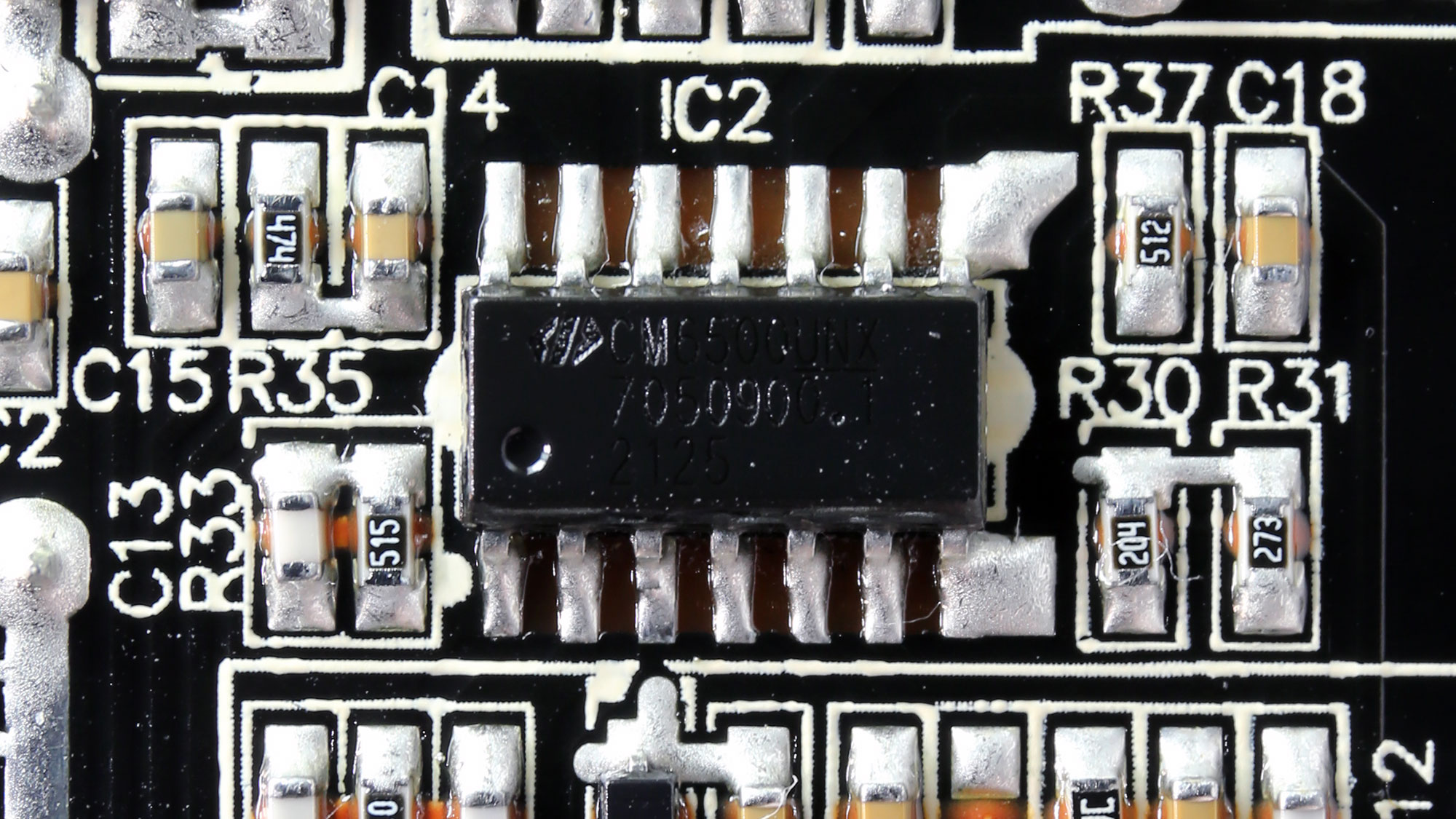
The APFC converter uses two NCE Power FETs and a single boost diode. The bulk cap is by Chemi-Con.




The main FETs are installed in a half-bridge topology. An LLC resonant converter is also used to boost efficiency.


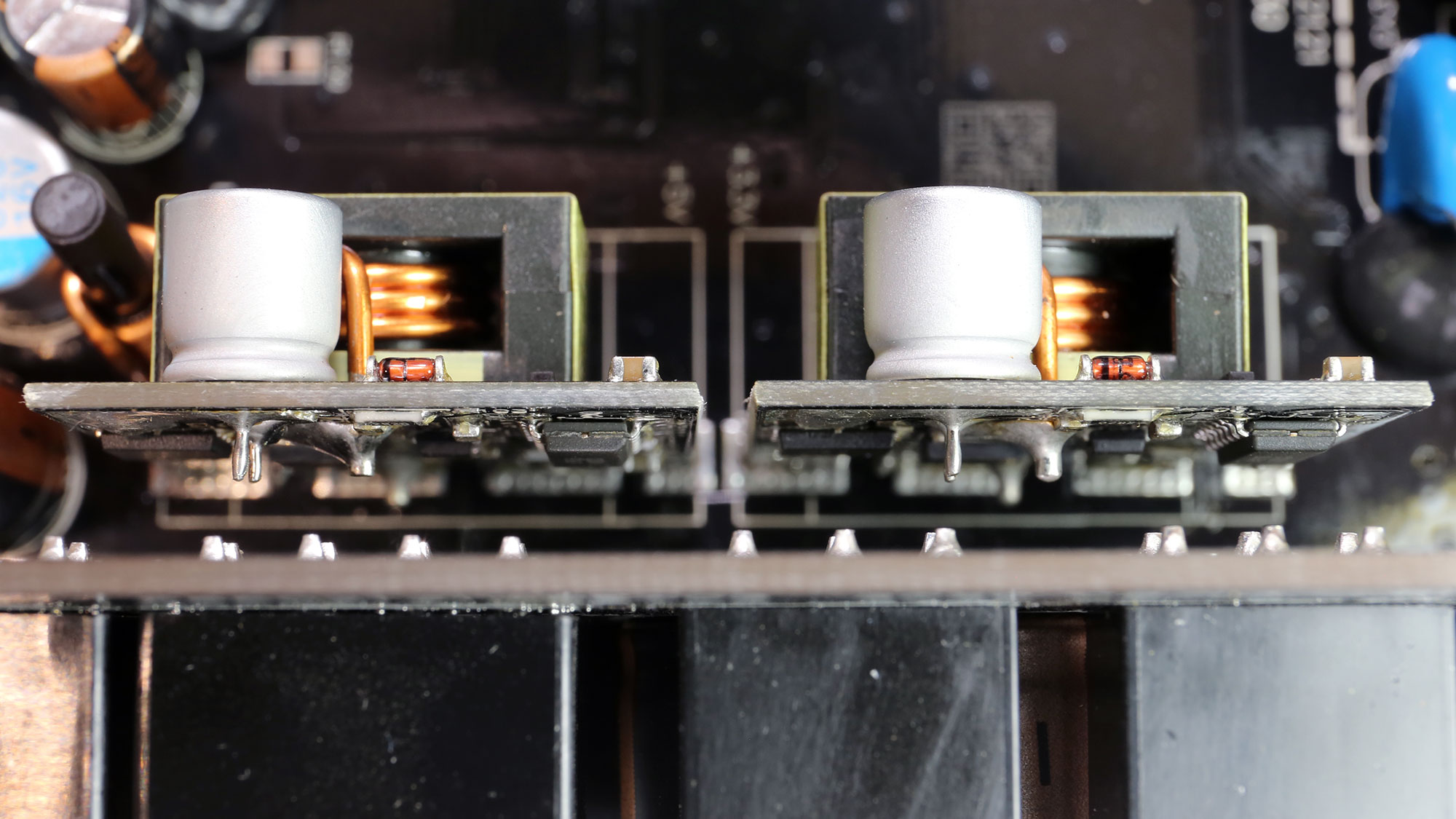
We couldn't identify the 12V FETs without desoldering the heat sinks, which could damage them, and we needed the PSU to be fully operational in case we need to retest it in the future.



The filtering caps are by Lelon. On paper, their specs are top-notch, but I'm typically skeptical of lesser-known manufacturers. Recent problems in capacitor manufacturing so getting hold of high-quality caps is challenging, if not impossible.


The standby PWM controller is a PR8109T IC.
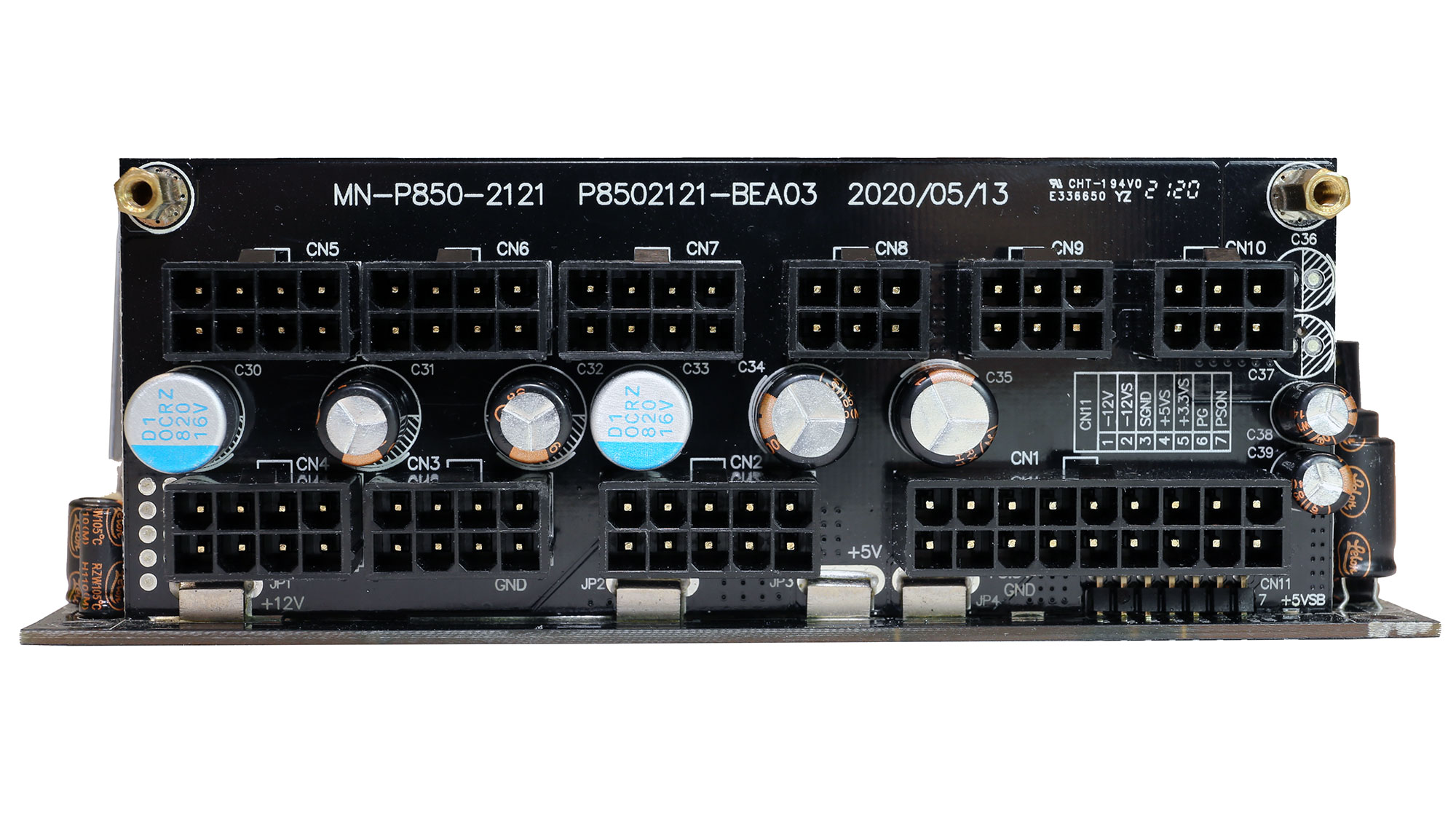

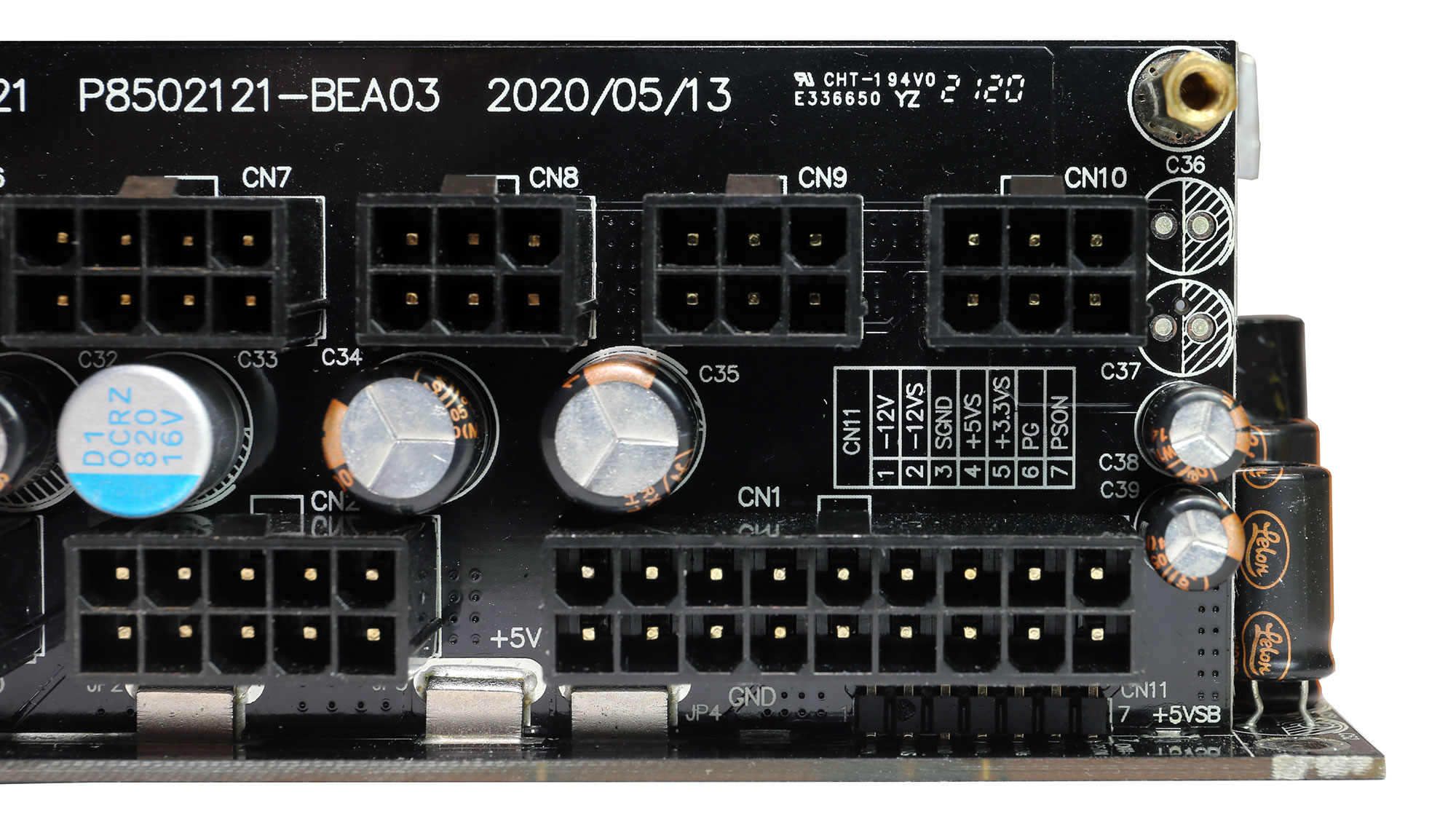
On the face of the modular board we find several electrolytic and polymer caps.

The main supervisor IC is a Weltrend WT7502R.




Soldering quality is excellent.


We are not fond of Yate Loon fans. Gigabyte should use another brand for the cooling fan, one of the most critical parts of a PSU.
MORE: Best Power Supplies
MORE: How We Test Power Supplies
MORE: All Power Supply Content
Current page: Specifications and Part Analysis
Next Page Load Regulation, Hold-Up Time, Inrush & Leakage Current, Efficiency and Noise
Aris Mpitziopoulos is a contributing editor at Tom's Hardware, covering PSUs.